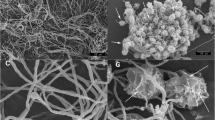Abstract
The chaperone CopZ together with the P-type ATPase transporter CopA constitute a copper-detoxification system in Bacillus subtilis that is commonly found in bacteria and higher cells. Previous studies of the regulation of the copZA operon showed that expression is significantly upregulated in response to elevated concentrations of environmental silver and cadmium, as well as copper. Here, we have used spectroscopic and bioanalytical methods to investigate in detail the capacity of CopZ to bind these metal ions (as Ag+ and Cd2+). We demonstrate that Ag+ binding mimics closely that of Cu+: Ag+-mediated dimerisation of the protein occurs, and distinct Ag+-bound species are formed at higher Ag+ loadings. Cd2+ also binds to CopZ, but exhibits significantly different behaviour. Cd2+-mediated dimerisation is only observed at low loadings, such that at 0.5 and one Cd2+ per CopZ the protein is present mainly in a monomeric form; and multinuclear higher-order forms of Cd2+–CopZ are not observed. Competition binding studies reveal that Ag+ binds with an affinity very similar to that of Cu+, while Cd2+ binding is significantly weaker. These data provide support for the proposal that CopZ may be involved in the detoxification of silver and cadmium, in addition to copper.









Similar content being viewed by others
Abbreviations
- BCS:
-
Bathocuproine disulfonate
- CD:
-
Circular dichroism
- ICP-AES:
-
Inductively coupled plasma atomic emission spectroscopy
- LMCT:
-
Ligand to metal charge transfer
- Mops:
-
3-Morpholinopropanesulfonate
References
Frausto da Silva JJR, Williams RJP (1991) The biological chemistry of the elements. Clarendon Press, Oxford
Kaim W, Rall J (1996) Angew Chem Int Ed 35:43–60
McMurray CT, Tainer JA (2003) Nat Gen 34:239–241
Silver S (2003) FEMS Microbiol Rev 27:341–353
Malmström BG, Leckner J (1998) Curr Opin Chem Biol 2:286–292
Rosenzweig AC, O’Halloran TV (2000) Curr Opin Chem Biol 4:140–147
Solioz M, Odermatt A (1995) J Biol Chem 270:9217–9221
Nies DH (1999) Appl Microbiol Biotechnol 51:730–750
Nies DH (2003) FEMS Microbiol Rev 27:313–339
Banci L, Bertini I, Del Conte R, Markey J, Ruiz-Duenas FJ (2001) Biochemistry 40:15660–15668
Kihlken MA, Leech AP, Le Brun NE (2002) Biochem J 368:729–739
Banci L, Bertini L, Ciofi-Baffoni S, D’Onofrio M, Gonnelli L, Marhuenda-Egea FC, Ruiz-Duenas FJ (2002) J Mol Biol 317:415–429
Radford DS, Kihlken MA, Borrelly GPM, Harwood CR, Le Brun NE, Cavet JS (2003) FEMS Microbiol Lett 220:105–112
Gaballa A, Helmann JD (2003) Biometals 16:497–505
Banci L, Bertini I, Ciofi-Baffoni S, Gonnelli L, Su XC (2003) J Biol Chem 278:50506–50513
Banci L, Bertini I, Ciofi-Baffoni S, Gonnelli L, Su XC (2003) J Mol Biol 331:473–484
Singleton C, Banci L, Ciofi-Baffoni S, Tenori L, Kihlken MA, Boetzel R, Le Brun NE (2008) Biochem J 411:571–579
Banci L, Bertini I, Ciofi-Baffoni S, Del Conte R, Gonnelli L (2003) Biochemistry 42:1939–1949
Huffman DL, O’Halloran TV (2001) Ann Rev Biochem 70:677–701
Smaldone GT, Helmann JD (2007) Microbiology 153:4123–4128
Liu T, Ramesh A, Ma Z, Ward SK, Zhang LM, George GN, Talaat AM, Sacchettini JC, Giedroc DP (2007) Nat Chem Biol 3:60–68
Solovieva IM, Entian KD (2004) FEMS Microbiol Lett 236:115–122
Moore CM, Gaballa A, Hui M, Ye RW, Helmann JD (2005) Mol Microbiol 57:27–40
Solovieva IM, Entian KD (2002) FEMS Microbiol Lett 208:105–109
Xiao Z, Loughlin F, George GN, Howlett GJ, Wedd AG (2004) J Am Chem Soc 126:3081–3090
Zhou L, Singleton C, Le Brun NE (2008) Biochem J. doi: 10.1042/BJ20080467
Leavitt S, Freire E (2001) Curr Opin Struct Biol 11:560–566
Laue TM, Shah BD, Ridgeway TM, Pelletier SL (1992) In: Harding SE, Rowe AJ, Horton J (eds) The analytical ultracentrifuge in biochemistry and polymer science. Royal Society of Chemistry, Cambridge, pp 90–125
Winge DR, Nielson KB, Gray WR, Hamer DH (1985) J Biol Chem 260:14464–14470
Zelazowski AJ, Gasyna Z, Stillman MJ (1989) J Biol Chem 264:17091–17099
Bofill R, Palacios O, Capdevila M, Cols N, González-Duarte R, Atrian S, González-Duarte P (1999) J Inorg Biochem 73:57–64
Willner H, Vašák M, Kägi JH (1987) Biochemistry 26:6287–6292
Hasler DW, Faller P, Vašák M (1998) Biochemistry 37:14966–14973
Henehan CJ, Pountney DL, Zerbe O, Vašák M (1993) Prot Sci 2:1756–1764
Dallinger R, Wang Y, Berger B, Mackay EA, Kägi JHR (2001) Eur J Biochem 268:4126–4133
Palacios O, Polec-Pawlak K, Lobinski R, Capdevila M, González-Duarte P (2003) J Biol Inorg Chem 8:831–842
Li H, Otvos JD (1996) Biochemistry 35:13929–13936
Urvoas A, Moutiez M, Estienne C, Couprie J, Mintz E, Le Clainche L (2004) Eur J Biochem 271:993–1003
Cotton FA, Wilkinson G, Murillo CA, Bochmann M (1999) Advanced inorganic chemistry. Wiley Interscience, New York, pp 598–633
Rulisek L, Vondrasek J (1998) J Inorg Biochem 71:115–127
Winge DR, Miklossy KA (1982) J Biol Chem 257:3471–3476
Daniels MJ, Turner-Cavet JS, Selkirk R, Sun H, Parkinson JA, Sadler PJ, Robinson NJ (1998) J Biol Chem 273:22957–22961
Matzapetakis M, Farrer BT, Weng TC, Hemmingsen L, Penner-Hahn JE, Pecoraro VL (2002) J Am Chem Soc 124:8042–8054
Wernimont AK, Huffman DL, Lamb AL, O’Halloran TV, Rosenzweig AC (2000) Nat Struct Biol 7:766–771
Banci L, Bertini I, Ciofi-Baffoni S, Su XC, Miras R, Bal N, Mintz E, Catty P, Shokes JE, Scott RA (2006) J Mol Biol 356:638–650
Acknowledgments
We thank the BBSRC for the award of studentships to C.S. and M.A.K., and the Wellcome Trust for an award from the Joint Infra-structure Fund for equipment. We are grateful to Tom Clarke and David Richardson for assistance with analytical ultracentrifugation experiments (the analytical ultracentrifugation facility at the University of East Anglia was funded by the Wellcome Trust and HEFCE) and Myles Cheesman and Andrew Thomson for access to spectroscopic instrumentation.
Author information
Authors and Affiliations
Corresponding author
Additional information
Margaret A. Kihlken and Chloe Singleton contributed equally to this work.
Electronic supplementary material
Below is the link to the electronic supplementary material.
Rights and permissions
About this article
Cite this article
Kihlken, M.A., Singleton, C. & Le Brun, N.E. Distinct characteristics of Ag+ and Cd2+ binding to CopZ from Bacillus subtilis . J Biol Inorg Chem 13, 1011–1023 (2008). https://doi.org/10.1007/s00775-008-0388-1
Received:
Accepted:
Published:
Issue Date:
DOI: https://doi.org/10.1007/s00775-008-0388-1




